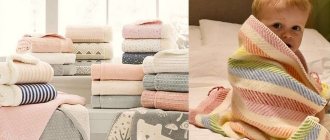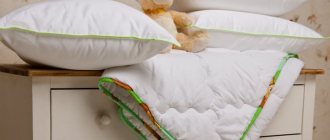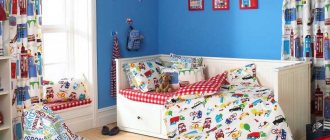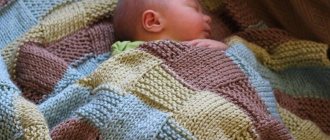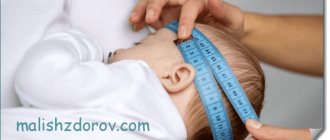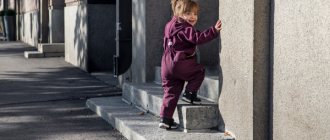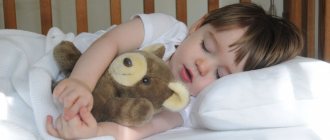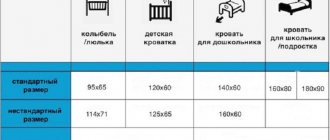A baby blanket provides the baby with a comfortable sleep and a pleasant rest in the crib. How to choose a warm blanket for walks in autumn or cold days in winter, light for spring days, weightless for the summer heat. What is the standard size of a blanket for babies of different ages in a crib or stroller? What to look for when choosing a baby blanket so that the child can easily “breathe” under it and at the same time be warm.
Various factors influence the choice of size
The size of a children's blanket for relaxation and walks should correspond to the age of the child. When choosing, you need to consider the following:
- the size of the product is determined by the baby’s age, height, build;
- thermal conductivity of the product. The circulation of warm air between the body and the blanket ensures a comfortable rest;
- hypoallergenic. The filler and material of the bedspread are environmentally friendly, made from natural raw materials;
- materials. Textile fabric and filler eliminate allergic reactions and overheating of the baby’s body;
- hygroscopicity. The blanket should absorb moisture, sweat, and any body secretions well;
- antistatic. Textile fabric should not accumulate static electricity.
When choosing a baby blanket, take into account the baby’s age, his build, the hypoallergenic nature of the product, and the dimensions of the crib.
Why is the size of a baby blanket important?
Due to their age, very young babies spend most of their time in a crib or playpen. The size of the baby blanket should correspond to the age, height, and build of the child. A blanket that is too small will not cover the baby completely; a large one will bunch up in folds. The choice of size depends on the intended purpose of the product. A small blanket can be used for walks outside, to cover the baby’s legs in a stroller, to cover it in cool weather, or to wrap the baby up to hold in your arms. The size of the blanket ensures comfortable rest and sleep. If the blanket is chosen incorrectly, unpleasant situations may arise:
- It is impossible to fully cover yourself with a small blanket and hide from the cold. The edges cannot be tucked under the mattress;
- something that is too big will slide down under the weight of its size and weight, forming a lump;
- under a large blanket the baby is lost and lacks confidence;
- It is difficult to choose a suitable duvet cover for a non-standard product size.
When is the purchase planned?
If the birth of a child is expected in the cool season, buy a larger blanket to securely wrap the baby and prevent colds and other diseases. During the warm summer season, buy a cotton blanket that will allow your baby's skin to breathe, while protecting him from bad weather, wind, and sun. Choose the size of the bedspread at your discretion. For warm weather, a small blanket is suitable.
How to choose?
Due to its versatility, a good blanket must meet certain parameters:
- ease;
- hypoallergenic and absence of harmful substances in the composition;
- ensuring sufficient ventilation and heat retention;
- comfort;
- ease of washing and care;
- design;
- price.
Keep in mind that single-color blankets in calm tones are more suitable for newborns and very young children. Bright and colorful products can irritate the baby. Older children like blankets with bright prints and images of their favorite cartoon characters.
In an area with variable weather, the best solution may be to buy two blankets (summer and winter) that can be worn together and used depending on the temperature.
The presence of silk in the product does not improve its properties, but does affect the price, and mixtures of synthetics and natural materials can cause allergies. Mothers and grandmothers who know how to knit can make a blanket from cotton or wool for a child themselves, the main thing is that the resulting product meets the parameters listed above.
Each age has its own standards
The sizes of children's blankets by age have their own standards. The parameters of the product depend on the child’s age, physique, and height. The dimensions of the bed also determine the size of the bedspread. The product should be wider and 15-20 cm longer than the crib. Restless, emotionally excitable children behave restlessly during sleep, spin around, and often turn over. The huge bedspread will be bunched up into rough folds. It is inconvenient for a restless, active baby to rest under such a blanket. Any baby blanket has its own standard sizes, which depend on the age and physical characteristics of the baby.
Standard sizes of blankets for newborns
The dimensions of the blanket for a newborn have standard characteristics. Basically it is 80 by 80 or 90 by 90 centimeters. The width and length allow the product to be used in sleeping places of non-standard dimensions (wide cradle, crib, stroller).
Standard sizes for baby blankets.
Table standard
| Child's age | Product dimensions in cm (width/length) |
| Newborn babies, children under 1 year | 80x80, 90x90, 95x95 are optimal for discharge from the maternity hospital 60x80, 80x100, 80x120, 85x115 are excellent for stroller cradle |
| Children from 1 year to 3 years | 90-100×120 |
| Children from 3 to 5 years old | 100-110x140 |
| Middle and high school students (teenagers) | 140-150x200-205-210 |
For discharge
For discharge from the maternity hospital, buy a product 75x75 cm, 80x80 cm, 90x90 cm. If the baby is large, the optimal size is 100x150 cm. A blanket for a newborn should be soft and pleasant.
To the cradle
For a cradle, buy a blanket 10-15 cm larger than the sleeping area. Then the product can be tucked under the mattress, preventing access of cool air to the baby’s body. For a child under the age of 5-6 months, a blanket of 60x90 cm is suitable. For children who are one year old, a blanket of 100x90 cm is suitable.
To bed
The size of a baby blanket for newborns in a crib must correspond to the size of the bed. The standard sizes of cribs are fixed in GOST. For children under three years old, the dimensions of the crib are 60 cm wide, 1 m 20 cm long. For older children, the width and length of the bed are 70x140 cm, respectively. The textile product must be no less than the size of the bed.
In the stroller
The standard size of a baby blanket for a stroller has standard dimensions in width from 60 cm to 100 cm, in length from 80 to 120 cm. The size of the blanket must correspond to the dimensions of the stroller. A blanket that is too large or bulky will be difficult to fit in the stroller. For children over 3 years old, the best bedspread size is 110x140 cm.
Features of Transformers
Transformable blankets are a ready-made cocoon envelope with zippers or buttons. It can be unzipped and converted into a regular bedspread. A comfortable, practical item for going out or for walks in the fresh air. In a cocoon blanket, the baby is securely protected from bad weather, wind, and rain.
Natural fiber is used as material for the transformer - knitwear, fleece, satin, wool, flannel, bamboo. For insulating the product, synthetic fillings made from synthetic padding polyester or holofiber are good, natural ones are sheep, goat wool, goose, chicken down. The transformation of the product occurs with the help of fasteners in the form of zippers, ribbons, buttons, buttons. Some models have a special pocket to hide the baby's legs and open the top. Transformable blankets are designed for different seasons. With insulation for the cool season (autumn, winter), lightweight for warm days.
For children under 3 years old
The size of a baby blanket for a crib is standard - for newborns the rectangular version is 60x120 cm, the square version is 90x90 cm. For a tall child of 3 years, choose a rectangular blanket, for a short one, a square one.
For children from 3 to 5 years old
For children from 3 to 5 years old, the optimal size of the blanket is 100-110 cm in width and 140-150 cm in length. For a large and tall child of this age, there are products ranging from 100-120 cm in width and 150-160 cm in length. Blanket size for a child 5 years 120x140-160 cm.
Preschoolers
The standard bedspread size for preschool children is 120-130 cm in width and 140-160-180 cm in length. It all depends on the child’s height and build.
Junior schoolchildren
For primary school students, a blanket of 100-110x140-160 cm is suitable. If the child’s height and weight correspond to his age.
Pupils
For middle school students, buy a blanket 120-125 cm wide and 150-160 cm long. At this age, the child is growing, so choose the length of the product according to his growth.
Teenagers
During adolescence, the body actively develops. The height, build, and weight of a teenager changes. The standard of blankets for young people in adolescence corresponds to the sizes for adults. 150-160 cm by 200-210 cm.
Non-standard options
Non-standard dimensions of a blanket are not common. If the child's height and weight do not correspond to his age, buy a blanket according to his physical characteristics. The width and length of the product is determined by height and build. It is difficult to choose a duvet cover for a blanket with non-standard parameters. The only way out is to have it made to order.
How to choose the right size
A blanket is an essential attribute of a comfortable sleep; it is used every day, starting from the first days of life.
Until recently, there were only 2 types of crib blanket sizes:
- for kids: 60x120 and 110x140 cm;
- for teenagers: 143x210.
Currently, there are many different models of different sizes on the textile market, which makes it difficult to choose, but allows you to choose a blanket that can provide the most comfortable conditions for a child’s rest and sleep. Taking into account the size of the purchased bedding is especially important for parents who do not plan to sew fabric covers themselves, which are worn to protect the blanket from dirt and premature wear, incl. due to frequent washing.
In such cases, you have to proceed from standards - standard sizes according to which domestic and foreign manufacturers sew bed linen. To ensure that the purchased blanket does not disappoint later, it is recommended to build on specific parameters.
The defining criteria are:
- age of the sleeper - the dimensions of a baby blanket are subject to standards developed specifically for newborns, one-year-old babies, preschoolers, and teenagers;
- Dimensions – height, weight, build. The age grouping is arbitrary; the individual characteristics of the child (large, thin, tall or short) should be taken into account. The selection rules are simple: the sleeping person fits completely under the blanket, is able to roll over freely, spread his arms and legs, and at the same time they do not “peek out” from under the blanket;
- size of the sleeping place - you should take into account what it is intended for, what functions the blanket will perform, the features of the bedding, the design of the bed, the method of dressing. This may be a non-standard product, such as a stroller envelope, or you plan to tuck a blanket under the mattress, use ties, buttons, Velcro - in these cases, precise measurements should be taken. If you purchase an ordinary classic blanket intended for a children's bed, cradle, transformable crib, or other furniture product, then according to generally accepted principles, it should create an airy atmosphere and be comparable to the dimensions of the bed - it is advisable to completely cover the sleeping area and have a small margin on three sides (except for the headboard).
Materials for baby blankets
Baby blankets are made from various materials. Textile fabric and filler must be of natural origin. The product must be safe and not cause allergic reactions or skin rashes.
Baykovoe
Fleece - natural fiber, soft pile. Delicate and cozy material. Does not require special care or storage conditions, does not irritate the skin. The basic basis of the bike is natural cotton. The flannelette blanket does not cause allergic reactions and is environmentally friendly. The weave structure of the fiber allows the body to “breathe”. For density and warmth, a little natural wool is added to the product, and synthetic viscose is added for strength. The biker is easy to wash and dry. Wear-resistant, decorative in appearance, a flannelette blanket has no disadvantages.
Down
Bedspreads made from natural down provide a warm, comfortable stay. Down is a special material. May cause allergies, overheat the body, and do not absorb moisture well. Down requires special care and special storage. The down blanket is wear-resistant and can last 20 years with proper care.
Cotton
A bedspread with cotton filling is the simplest, most common product. The main raw material is cotton wool, which is made from cotton. Hypoallergenic, very warm. There are disadvantages - high flammability, difficult maintenance, the possibility of insects appearing in the filler.
Bamboo
Bamboo fiber is a natural raw material. Bamboo does not cause allergies, is easy to care for, warms well, and is pleasant to the touch. An ideal product for kids and adults. A bamboo blanket is light, weightless, absorbs and releases moisture well.
Fleece
Fleece is a synthetic knitwear. Pleasant, soft to the touch. Provides good air circulation around the body, does not cause allergies, and is easy to use and care.
Woolen
Blankets made from natural wool can be pure wool, half-wool with the addition of synthetic fibers. The structure and quality characteristics of wool from sheep, goats, llamas, and camels differ from each other. Woolen products are prone to easily absorb foreign odors and aromas; they are easily infested with larvae of moths, ticks, and other insects. At the same time, the wool blanket is very warm and comfortable. May cause allergies in children with weak immune systems.
Silk
Natural silk is the most prestigious, high-quality material. Extraordinary properties, high quality, light weightlessness. Children who are one year old or older will appreciate the sliding pleasantness of the material. A child's sleep under a silk blanket will be comfortable and serene.
Synthetic
Synthetic fibers - padding polyester, holofiber, ecofiber. The material does not cause allergies, does not collect dust, and eliminates the appearance of bed mites and moths. Poor air permeability and deformation due to frequent washing. Warm, light.
Materials and sizes
The outer material of the envelope should protect the baby from wind, snow and rain - usually specially treated polyester copes well with these functions. The most commonly used winter insulation materials are down, sheepskin, fleece and polymer materials such as holofiber or polyester. If you suspect that your baby is at high risk of allergies to fur and feathers, it is better to choose a synthetic filler that is machine washable. And fleece will come in handy in warm winters or cold off-seasons.
Looking for an envelope for very cold weather? Choose models with duck down, eco-down or sheep's wool. They will warm you up and keep you warm for a long time.
A summer or inter-season envelope is usually made of fleece and an outer water-repellent material. Also, the inner layer can be made of bamboo or soft cotton. This option is good for bad weather in spring, autumn and even in cold weather in summer.
Be sure to make sure that the inner layer of winter overalls for a newborn is trimmed with fur, cotton or fleece, but not with raincoat fabric or other materials that do not allow moisture to pass through. Otherwise, the baby will sweat while you carry him from the house to the street, to the car, and so on.
The sizes of the envelopes are selected according to the baby’s height. At birth, the average height is from 46 to 50 cm, but if you walk with your baby in an envelope all winter, then, of course, during this time he will grow considerably - by about 10 cm. Take this point into account when purchasing.
When choosing a winter envelope for an older baby, make sure that the inside of the envelope, where the legs are located, is made of waterproof material. This will be very useful when walking with a child who may step in the mud or simply walk through snowdrifts. You can immediately put your baby in the stroller and not be afraid of getting the envelope dirty.
Some models allow you to adjust the protection using an elastic band on the drawstring. When a strong wind blows, you can tighten the elastic band, thus surrounding your baby with a windproof cocoon in which he can sleep warmly and sweetly.
What else should you consider when choosing a baby blanket?
Select the size of the baby blanket according to the height and weight of the child. In addition, pay attention to the material, quality of tailoring, and firmware of the product. High-quality stitching securely secures the filler in the cells. A well-quilted item extends its service life. The stitch can be figured or cassette. The design and design of the blanket are important for the product; it should be useful and beautiful.
One or one-half blanket
A single blanket is designed for one person. It has standard dimensions of width 140 cm, length 2000 cm. For children, the length of the product is shorter, approximately 160-170 cm. A one-and-a-half-size blanket can cover one or two people. The standard width is 150-160 cm. Single and double bedspreads are useful for teenagers and adults.
Selecting a design
The appearance of the bedspread is determined by the age of the child and his physiological needs. For your baby, you can choose a bright quilted bedspread using the patchwork technique. Patchwork quilts look elegant, light, airy. The appearance of the item must correspond to the overall design of the room space, be combined with a crib, chest of drawers, and other bedroom furniture, and be in harmony with the textiles on the windows. A figured stitch can revive and decorate the fabric of a blanket. A beautifully quilted blanket looks especially impressive on a plain fabric.
Thickness
The thickness of the product depends on its seasonal use. A summer-spring blanket can be 0.5-1 cm thick. For winter, choose a thicker product of 3-5 cm. Although the thickness of the blanket does not affect thermal conductivity. Heat retention depends on the internal filler. A thin blanket made of natural wool warms no worse than a thick blanket made of cotton. The presence of a duvet cover creates and retains warm air between the duvet itself and the cover.
What color of baby blanket to choose for a girl and a boy
Common colors for boys and girls are blue and pink. For a girl, choose a blanket in pink, red, pearl, and yellow colors. For a boy, blue, dark blue, and chocolate colors are suitable. A combination of primary colors and shades will enrich the decor of the room.
Simple Crochet Pattern
For a knitted blanket for a newborn measuring 80 x 100 cm, you will need from 350 to 500 g of yarn, depending on the thickness of the thread and its quality, as well as the density of the knitting. To work you need a hook number 3.5.
Make a yarn test: knit a sample square measuring 12 x 12 cm. Using it, determine how many loops you got in 1 cm in height and width. Accordingly, cast on as many chain loops to get a chain 100 cm long.
Scheme of the initial row: the first double crochet is placed in the 3rd loop from the hook, then one double crochet is placed in each subsequent loop of the chain until the end of the line. Turn the knitting over.
Scheme of the second and subsequent rows: at the beginning, 2 air loops are made to lift the row, then double crochets are made in the same way as in the first row.
The edge is tied with single crochets, and then with a “crawfish step”: single crochets are drawn from left to right, as if “backing away”. The result will be a neat, dense edge that will hold its shape well.
Knitting pattern and plan
Decor options:
- alternating stripes of different colors every 2-8 rows;
- the use of narrow and wide multi-colored rows;
- “chess” (alternating multi-colored squares);
- satin ribbon passed through a row of double crochets in a dotted line.
If the work is carried out in two colors, then the thread can be pulled along the edge of the product without cutting it. If several colors are used, the yarn is cut. The ends of the threads should be securely fastened and hidden.
Fashionable blanket for the crib
Famous manufacturers
Well-known manufacturers of children's bedding textiles in Russia offer consumers products made from natural, environmentally friendly materials, exclusive design, and high quality.
- The Russian one produces beautiful blankets made from natural cotton knitwear with spectacular decor, prints, and inscriptions. Envelopes for discharge from the maternity hospital, for walks in the fresh air, and sets of underwear for infants are designed in soft pastel colors.
- The Ecoline bed textile factory produces children's products for newborns, sleep, relaxation, and active games. Bedding sets for cribs and cradles, consisting of a blanket, blanket, pillows, mattress, bumpers, soft toys. Envelopes for discharge, a nest for babies and many other products for newborns are designed in delicate colors, materials, cut and tailoring are of the highest quality.
- The Russian enterprise TM Choupette produces bedding, clothing, and soft products for newborns. Uses natural materials, modern design.
What is the envelope for?
Even if a stroller is made to take into account the changeable and sometimes harsh weather in our latitudes, it still does not provide the warmth that a newborn needs. That's why our mothers wrapped us in thick, warm blankets. Nowadays it’s not enough to simply wrap up a baby - we constantly transport children in cars and strollers, sometimes we pick them up in our arms on the street to calm them down. And, of course, many modern stroller envelopes have appeared that are very comfortable for small children and their parents.
Sewing a crib set yourself
You can make a bedding set for your crib yourself. Information about baby blankets and sizes can be found on the Internet. First, decide what set you need - mattress, blanket, pillow, bumpers.
Preparatory stage
At the preparatory stage, purchase all the necessary materials based on the size of the future kit. Textiles, internal filling, decorative elements, stock (threads, buttons, zippers, buttons). Check the size of the future product. If necessary, make a pattern. Choose environmentally friendly fabric from natural fibers. The finished product must conduct air well, be warm, hygroscopic, and light.
Uncover
Using a standard pattern or individual measurements, mark the cut details on the fabric with seam allowances of 1.5-2 cm. Cut the bedspread filling in accordance with the dimensions of the main textile. Prepare all parts for stitching. Filling in two layers is not cut, but folded in half to create the thickness of the blanket.
Sewing process
Carefully stitch and connect all the parts. The cover can be sewn in patchwork style or from a single solid or colored piece of fabric. Place filler between the top and bottom layers of the blanket, stitch along the perimeter, and trim the edges with piping or trim cut on the bias. To strengthen the filler, place a straight or figured stitch over the entire surface of the product.
